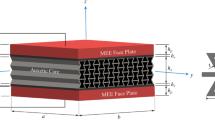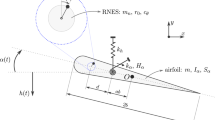Abstract
The dynamic performance of a micro-resonator depends on its energy loss mechanism which is quantified by Q-factor (Quality factor). This paper presents numerical and analytical modelling techniques to understand the air damping on energy loss and Q-factor in enclosed micro-resonators. A complete finite element based numerical model is presented that can recreate a vacuum packaged MEMS resonators operating condition and capture its Q-factor for various design and pressure conditions. The finite element model was then compared with analytical models available in the literature. In this work, various vacuum regions relevant to encapsulated MEMS resonators are investigated using analytical and finite element approaches for pressure ranges of < 1 Pa, 1–10 Pa, and 10–100 Pa. When the pressure decreases, the Q factor from finite element analysis and the analytical model exponentially increases until it levels off in intrinsic damping. The modelling techniques described in this paper are compared with previously reported experimental work showing good qualitative agreement of the change in Q-factor with pressure. Air damping is divided into squeeze film damping and slide film damping to further explore damping effects and squeeze film damping is found to be the dominant energy loss mechanism in the studied device. In a gap-closing structure, the air gaps between moving structure and fixed fingers create squeeze film damping and cause energy loss while the smaller air gaps between them generate large forces, increasing the damping. The modelling techniques presented in this paper can be applied generically to MEMS resonators to mitigate air damping losses.













Similar content being viewed by others
References
Ahamed MJ, Senkal D, Shkel AM (2014) Effect of annealing on mechanical quality factor of fused quartz hemispherical resonator. In: 1st IEEE Int. Symp. Inert. Sensors Syst. ISISS 2014—Proc., no. c, pp 18–21 https://doi.org/10.1109/ISISS.2014.6782512
Bao M (2005) Analysis and design principles of MEMS devices, 1st edn. Elsevier, Amsterdam
Bao M, Yang H (2007) Squeeze film air damping in MEMS. Sens Actuat A Phys 136(1):3–27. https://doi.org/10.1016/j.sna.2007.01.008
Bao M, Yang H, Yin H, Sun Y (2002) Energy transfer model for squeeze-film air damping in low vacuum. J Micromechan Microeng 12(3):341–346. https://doi.org/10.1088/0960-1317/12/3/322
Boom BA, Bertolini A, Hennes E, van den Brand JFJ (2021) Gas damping in capacitive mems transducers in the free molecular flow regime. Sensors 21(7):1–13. https://doi.org/10.3390/s21072566
Candler RN et al (2006) Long-term and accelerated life testing of a novel single-wafer vacuum encapsulation for MEMS resonators. J Microelectromechan Syst 15(6):1446–1456. https://doi.org/10.1109/JMEMS.2006.883586
Chiao M, Lin L (2002) Sealing technologies. Inst. Eng. Technol. retrieved from www.knovel.com
Christian R (1966) The theory of oscillating-vane vacuum gauges. Vacuum 16(4):175–178. https://doi.org/10.1016/0042-207X(66)91162-6
Dennis JO, Ahmed AY, Khir MH, Rabih AAS (2015) Modelling and simulation of the effect of air damping on the frequency and quality factor of a CMOS-MEMS Resonator. p 10
Du Q et al (2018) Quality factor determination and improvement of piezoelectric driving multilayer resonator. J Micromech Microeng. https://doi.org/10.1088/1361-6439/aac2f3
Fedeli P, Frangi A, Laghi G, Langfelder G, Gattere G (2017) Near vacuum gas damping in MEMS: simplified modeling. J Microelectromech Syst 26(3):632–642. https://doi.org/10.1109/JMEMS.2017.2686650
Feng C, Jiang LY (2011) Molecular dynamics simulation of squeeze-film damping effect on nano resonators in the free molecular regime. Phys E Low-Dimensl Syst Nanostruct 43(9):1605–1609. https://doi.org/10.1016/j.physe.2011.05.004
Frangi A, Frezzotti A, Lorenzani S (2007) On the application of the BGK kinetic model to the analysis of gas-structure interactions in MEMS. Comput Struct 85(11–14):810–817. https://doi.org/10.1016/j.compstruc.2007.01.011
Frangi A, Ghisi A, Coronato L (2009) On a deterministic approach for the evaluation of gas damping in inertial MEMS in the free-molecule regime. Sens Actuat A 149(1):21–28. https://doi.org/10.1016/j.sna.2008.09.018
Frangi A, Fedeli P, Laghi G, Langfelder G, Gattere G (2016) Near vacuum gas damping in MEMS: numerical modeling and experimental validation. J Microelectromech Syst 25(5):890–899. https://doi.org/10.1109/JMEMS.2016.2584699
Ghaffari S et al (2015) Accurate modeling of quality factor behavior of complex silicon MEMS resonators. J Microelectromech Syst 24(2):276–288. https://doi.org/10.1109/JMEMS.2014.2374451
Hutcherson S, Ye W (2004) On the squeeze-film damping of micro-resonators in the free-molecule regime. J Micromechan Microeng 14(12):1726–1733. https://doi.org/10.1088/0960-1317/14/12/018
Itoh T, Okada H, Takagi H, Maeda R, Suga T (2003) Room temperature vacuum sealing using surface activated bonding method. In: Transducers 2003—12th Int. Conf. solid-state sensors, actuators microsystems, Dig. Tech. Pap., vol. 2, pp 1828–1831, https://doi.org/10.1109/SENSOR.2003.1217143
Jennings SG (1988) The mean free path in air. J Aerosol Sci 19(2):159–166. https://doi.org/10.1016/0021-8502(88)90219-4
Khan N, Ahamed MJ (2020) Design and development of a MEMS butterfly resonator using synchronizing beam and out of plane actuation. Microsyst Technol 26(5):1643–1652. https://doi.org/10.1007/s00542-019-04705-8
Khan I, Ting DSK, Ahamed MJ (2020) Design and development of a MEMS vibrating ring resonator with inner rose petal spring supports. Microsyst Technol. https://doi.org/10.1007/s00542-020-05001-6
Kucera M, Manzaneque T, Sánchez-Rojas JL, Bittner A, Schmid U (2013) Q-factor enhancement for self-actuated self-sensing piezoelectric MEMS resonators applying a lock-in driven feedback loop. J Micromech Microeng. https://doi.org/10.1088/0960-1317/23/8/085009
Li Q et al (2018) 0.04 degree-per-hour MEMS disk resonator gyroscope with high-quality factor (510 k) and long decaying time constant (74.9 s). Microsyst Nanoeng 4(1):32. https://doi.org/10.1038/s41378-018-0035-0
Lisec T, Reinert W (2010) Hermetic and reliable wafer-level packaging for MEMS. In: 7th ESA Round Table Micro Nano Technol. Sp. Appl
Manual R (2018) COMSOL Multiphysics® v. 5.5 Reference Manual, p 1742
Pickering P, Twanow C, Spicer D (2018) Using wafer level packaging to improve sensor manufacturability and cost. MEMS Packag, pp 53–70
Ren S, Yuan W, Qiao D, Deng J, Sun X (2013) A micromachined pressure sensor with integrated resonator operating at atmospheric pressure. Sensors 13(12):17006–17024. https://doi.org/10.3390/s131217006
Rodriguez J et al (2019) Direct detection of akhiezer damping in a silicon MEMS resonator. Sci Rep 9(1):2244. https://doi.org/10.1038/s41598-019-38847-6
Santos JT, Holz T, Fernandes AJS, Costa FM, Chu V, Conde JP (2015) Pressure effects on the dissipative behavior of nanocrystalline diamond microelectromechanical resonators. J Micromechan Microeng. https://doi.org/10.1088/0960-1317/25/2/025019
Senkal D et al. (2014) 100K Q-factor toroidal ring gyroscope implemented in wafer-level epitaxial silicon encapsulation process. In: Proc. IEEE Int. Conf. Micro Electro Mech. Syst., pp 24–27, https://doi.org/10.1109/MEMSYS.2014.6765564
Senkal D, Ahamed MJ, Ardakani MHA, Askari S, Shkel AM (2015) Demonstration of 1 million Q-factor on microglassblown wineglass resonators with out-of-plane electrostatic transduction. J Microelectromechan Syst 24(1):29–37. https://doi.org/10.1109/JMEMS.2014.2365113
Shmulevich S, Lerman M, Elata D (2013) On the quality of quality-factor in gap-closing electrostatic resonators. J Micromech Microeng. https://doi.org/10.1088/0960-1317/23/11/115010
Suttisintong K, White JD (2015) Synthesis of two subunits of the macrolide domain of the immunosuppressive agent sanglifehrin A and assembly of a macrolactone precursor. Application of masamune anti-aldol condensation. J Org Chem 80(4):2249–2262. https://doi.org/10.1021/jo5027595
Taheri-Tehrani P, Defoort M, Horsley DA (2017) Operation of a high quality-factor gyroscope in electromechanical nonlinearities regime. J Micromechan Microeng. https://doi.org/10.1088/1361-6439/aa73af
Tang W, Zhang X (2019) Viscous air damping in laterally driven microresonators. Sens Mater 7(6):415–430
Van Toan N, Kubota T, Sekhar H, Samukawa S, Ono T (2014) Mechanical quality factor enhancement in a silicon micromechanical resonator by low-damage process using neutral beam etching technology. J Micromech Microeng. https://doi.org/10.1088/0960-1317/24/8/085005
Wang W, Luo Z, Dan Q, Xu Y, Liu S (2013) Structure-air damping coupling analysis of micromachined gyroscope. In: 2013 14th International Conference on Electronic Packaging Technology (ICEPT), 2013, pp 1280–1283, https://doi.org/10.1109/ICEPT.2013.6756691
Yang W, Li H, Chatterjee AN, Elfadel IM, Ocak IE, Zhang T (2017) A novel approach to the analysis of squeezed-film air damping in microelectromechanical systems. J Micromechan Microeng 27(1):15012. https://doi.org/10.1088/0960-1317/27/1/015012
Zhou W et al (2014) Air damping analysis in comb microaccelerometer. Adv Mech Eng 6:373172. https://doi.org/10.1155/2014/373172
Acknowledgements
Authors would like to thank MITACS and Teledyne Micralyne for financial supports. The authors also thank CMC Microsystems for CAD tools support.
Author information
Authors and Affiliations
Contributions
All authors contributed to the manuscript. All authors have given approval to the final version of the manuscript.
Corresponding author
Additional information
Publisher's Note
Springer Nature remains neutral with regard to jurisdictional claims in published maps and institutional affiliations.
Rights and permissions
Springer Nature or its licensor holds exclusive rights to this article under a publishing agreement with the author(s) or other rightsholder(s); author self-archiving of the accepted manuscript version of this article is solely governed by the terms of such publishing agreement and applicable law.
About this article
Cite this article
Wang, A., Sahandabadi, S., Harrison, T. et al. Modelling of air damping effect on the performance of encapsulated MEMS resonators. Microsyst Technol 28, 2529–2539 (2022). https://doi.org/10.1007/s00542-022-05385-7
Received:
Accepted:
Published:
Issue Date:
DOI: https://doi.org/10.1007/s00542-022-05385-7




